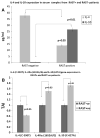Single nucleotide polymorphisms (SNPs) in key cytokines may modulate food allergy phenotypes
- PMID: 23230389
- PMCID: PMC3516859
- DOI: 10.1007/s00217-012-1827-3
Single nucleotide polymorphisms (SNPs) in key cytokines may modulate food allergy phenotypes
Abstract
Single nucleotide polymorphisms (SNPs) can play a direct or indirect role in phenotypic expression in food allergy pathogenesis. Our goal was to quantitate the expression of SNPs in relevant cytokines that were expressed in food allergic patients. SNPs in cytokine genes IL-4 and IL-10 are known to be important in IgE generation and regulation. We examined IL-4 (C-590T), IL-4Rα (1652A/G) and IL-10 (C-627A) SNPs using real-time PCR followed by restriction fragment length polymorphism (RFLP) analysis. Our results show that the AA, AG and GG genotypes for IL-4Rα (1652A/G) polymorphisms were statistically different in radioallergosorbent test (RAST) positive versus negative patients, and although no statistically significant differences were observed between genotypes in the IL-4 (C-590T) and IL-10 (C-627A) SNPs, we observed a significant decrease in IL-4 (C-590T) gene expression and increase in IL-4Rα (1652A/G) and IL-10 (C-627A) gene expression between RAST(+) versus RAST(-) patients, respectively. We also observed significant modulation in the protein expression of IL-4 and IL-10 in the serum samples of the RAST(+) patients as compared to the RAST(-) patients indicating that changes in SNP expression resulted in altered phenotypic response in these patients.
Figures




References
-
- Branum AM, Lukacs SL. Food allergy among U.S. children: trends in prevalence and hospitalizations. NCHS Data Brief. 2008;10:1–8. - PubMed
Grants and funding
LinkOut - more resources
Full Text Sources
Other Literature Sources
